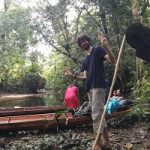While deforestation rates have decreased dramatically over the 2005-2015 period, forest degradation resulting from logging and wildfires became the major source of aboveground biomass losses and the Brazilian Amazon turned into a carbon source (Gatti et al., 2021; Qin et al., 2021). Since 2015, deforestation rates and associated fires are rising again, and new deforestation frontiers are opening up in previously untouched areas in the central and western Amazon (Silva Junior et al., 2020). The persistence of fires in the regions could undermine the capacity of Brazil to reach its carbon emission reduction commitments (da Silva Junior et al., 2020).
Fire regimes in tropical rainforest are complex dynamics driven by closely intervened climatic, ecological and socio-economic factors acting at multiple scale. Despite their critical role in forest degradation and carbon emissions, fire regimes in tropical rainforest and effective ways to reduce them are still poorly understood. The aim of this research project would be to understand the different drivers of fire regimes and how they interact using an interdisciplinary approach.
Fires in the Brazilian Amazon are related to land use dynamics: they are initially used to transform forests into pastures or cropland, frequent subsequent burnings favour the regrowth of grass over trees and can give the appearance of fertilizing the soil at a low or no cost. When nearby rainforests are dry enough, because of generalized drought over the Amazon basin or fragmentation of the forest cover, deforestation and agricultural fires escape into nearby forests and can cause large wildfires (Cano-Crespo et al., 2015). Local communities fire management practices, such as the timing of ignitions and prevention measures taken to prevent fire escape, can have an important impact on regional fires regimes. Burn experiments have demonstrated that even low-intensity fires can lead to tree mortality and canopy damage, increasing the fuel load and creating drier microclimatic conditions, ultimately resulting in larger and more intense fires (Balch et al., 2015; Brando et al., 2014).
At a regional scale, feedback between fires and deforestation exist: deforestation and smoke from associated fires reduce local precipitation, promoting tree mortality and widespread fires. Associated reduction of the forest cover decreases evapotranspiration and disrupts the hydrological cycle in the region, reducing the area with levels of precipitation that are compatible with the persistence of rainforest and potentially leading to massive forest die-back (Nepstad et al., 2008). Fire is therefore likely to act as a catalyst, accelerating the transition from rainforest to seasonal forest and savanna and preventing regeneration of forest on abandoned pastures (Malhi et al., 2009).
Regarding the limited impact of past environmental policies to reduce forest degradation, rising deforestation and the existence of strong feedback between fires, deforestation and climate that could lead to massive forest dieback, there is an urgent need to better understand the drivers of fire regimes in the region and to inform solutions to reduce wildfire frequency. Thus, this research project aims to:
- Identify the drivers of fire regimes in the Brazilian Amazon
- Assess the impact of the environmental policies that aimed to reduce deforestation on the fire regimes and fire management practices by local communities
- Compare the accuracy of different disciplinary approaches and data sources for studying fire regimes and their drivers in tropical rainforest
To evaluate these aims, a spatio-temporal model of fire regimes in the Brazilian Amazon using MODIS Active-Fires data for the 2003-2020 period will be developed. The spatio-temporal model will be used to understand the relative importance of different drivers. The explanatory variables tested will relate to climatic, ecological and socio-economic drivers identified through the literature review. During the second phase of the project, fieldwork will be conducted in protected areas to investigate results from the modelling exercise, as well as fire management practices by local communities, how these practices evolved and what forms of communal governance of fires exists. Finally, the accuracy of different sources for identifying fires and a comparison of the results from modelling and fieldwork exercise will be carried out.

Figure 1: Fire frequency after the establishment of protected areas/indigenous lands in the Brazilian Amazon (2003-2019 period, or after the official designation of the protected areas/indigenous land).
Literature
Balch, J.K., Brando, P.M., Nepstad, D.C., Coe, M.T., Silvério, D., Massad, T.J., Davidson, E.A., Lefebvre, P., Oliveira-Santos, C., Rocha, W., Cury, R.T.S., Parsons, A., Carvalho, K.S., 2015. The Susceptibility of Southeastern Amazon Forests to Fire: Insights from a Large-Scale Burn Experiment. BioScience 65, 893–905. https://doi.org/10.1093/biosci/biv106
Brando, P.M., Balch, J.K., Nepstad, D.C., Morton, D.C., Putz, F.E., Coe, M.T., Silverio, D., Macedo, M.N., Davidson, E.A., Nobrega, C.C., Alencar, A., Soares-Filho, B.S., 2014. Abrupt increases in Amazonian tree mortality due to drought-fire interactions. Proceedings of the National Academy of Sciences 111, 6347–6352. https://doi.org/10.1073/pnas.1305499111
Cano-Crespo, A., Oliveira, P.J.C., Boit, A., Cardoso, M., Thonicke, K., 2015. Forest edge burning in the Brazilian Amazon promoted by escaping fires from managed pastures: J. Geophys. Res. Biogeosci. 120, 2095–2107. https://doi.org/10.1002/2015JG002914
da Silva Junior, C.A., Teodoro, P.E., Delgado, R.C., Teodoro, L.P.R., Lima, M., de Andréa Pantaleão, A., Baio, F.H.R., de Azevedo, G.B., de Oliveira Sousa Azevedo, G.T., Capristo-Silva, G.F., Arvor, D., Facco, C.U., 2020. Persistent fire foci in all biomes undermine the Paris Agreement in Brazil. Sci Rep 10, 16246. https://doi.org/10.1038/s41598-020-72571-w
Gatti, L.V., Basso, L.S., Miller, J.B., Gloor, M., Gatti Domingues, L., Cassol, H.L.G., Tejada, G., Aragão, L.E.O.C., Nobre, C., Peters, W., Marani, L., Arai, E., Sanches, A.H., Corrêa, S.M., Anderson, L., Von Randow, C., Correia, C.S.C., Crispim, S.P., Neves, R.A.L., 2021. Amazonia as a carbon source linked to deforestation and climate change. Nature 595, 388–393. https://doi.org/10.1038/s41586-021-03629-6
Malhi, Y., Aragao, L.E.O.C., Galbraith, D., Huntingford, C., Fisher, R., Zelazowski, P., Sitch, S., McSweeney, C., Meir, P., 2009. Exploring the likelihood and mechanism of a climate-change-induced dieback of the Amazon rainforest. Proceedings of the National Academy of Sciences 106, 20610–20615. https://doi.org/10.1073/pnas.0804619106
Nepstad, D.C., Stickler, C.M., Filho, B.S.-, Merry, F., 2008. Interactions among Amazon land use, forests and climate: prospects for a near-term forest tipping point. Phil. Trans. R. Soc. B 363, 1737–1746. https://doi.org/10.1098/rstb.2007.0036
Qin, Y., Xiao, X., Wigneron, J.-P., Ciais, P., Brandt, M., Fan, L., Li, X., Crowell, S., Wu, X., Doughty, R., Zhang, Y., Liu, F., Sitch, S., Moore, B., 2021. Carbon loss from forest degradation exceeds that from deforestation in the Brazilian Amazon. Nat. Clim. Chang. https://doi.org/10.1038/s41558-021-01026-5
Silva Junior, C.H.L., Aragão, L.E.O.C., Anderson, L.O., Fonseca, M.G., Shimabukuro, Y.E., Vancutsem, C., Achard, F., Beuchle, R., Numata, I., Silva, C.A., Maeda, E.E., Longo, M., Saatchi, S.S., 2020. Persistent collapse of biomass in Amazonian forest edges following deforestation leads to unaccounted carbon losses. Sci. Adv. 6, eaaz8360. https://doi.org/10.1126/sciadv.aaz8360









